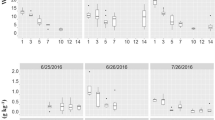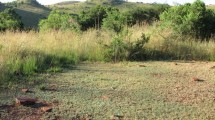Abstract
Livestock dung provides an important direct pathway by which carbon and nutrients enter soils in pasture ecosystems and affects carbon and nitrogen cycling indirectly through changes in soil and plant properties. Here, we quantify dung deposition, decomposition, and the effects of dung on soil and plants in a Zoysia japonica grassland in Japan. We determined (1) the distribution of dung, (2) the mass loss rate of dung and the amount of carbon respired as CO2, and (3) changes in soil properties and aboveground biomass of Z. japonica. Dung deposition was 4.0–9.7 g C and 0.4–1.0 g N m−2 year−1 and distributed patchily (Morishita’s I δ > 1). Most (71 %) of the carbon in dung deposited in June was lost within a single grazing period by aerobic decomposition, more than mass loss rate of Z. japonica litter in the first year (about 50 %), suggesting that grazing and defecation can accelerate carbon cycling compared with the typical litterfall–decomposition regime. Nitrogen in dung mass entered the soil as ammonium nitrogen and was nitrified. The spatiotemporal distribution of these processes corresponded to that of stimulated Z. japonica growth. These results suggested that dung deposition significantly affected the inorganic nitrogen status of soil and, therefore, the growth of Z. japonica. However, these effects were very restricted temporally (July–August) and spatially (within 10 cm from dung edge). Thus, such spatiotemporally restricted effects combined with the patchy distribution of dung may contribute to the heterogeneous structure of pasture ecosystems.








Similar content being viewed by others
References
Aarons SR, Hosseini HM, Dorling L, Gourley CJP (2004a) Dung decomposition in temperate dairy pastures II. Contribution to plant available soil phosphorus. Aust J Soil Res 42:115–123
Aarons SR, O’Connor CR, Gourley CJP (2004b) Dung decomposition in temperate dairy pastures I. Changes in soil chemical properties. Aust J Soil Res 42:107–114
Aarons SR, O’Connor CR, Hosseini HM, Gourley CJP (2009) Dung pads increase pasture production, soil nutrients and microbial biomass carbon in grazed dairy systems. Nutr Cycl Agroecosyst 84:81–92
Adler P, Raff D, Lauenroth W (2001) The effect of grazing on the spatial heterogeneity of vegetation. Oecologia 128:465–479
Anduaga S (2004) Impact of the activity of dung beetles (Coleoptera: Scarabaeidae: Scarabaeinae) inhabiting pasture land in Durango, Mexico. Environ Entomol 33:1306–1312
Bekku Y, Koizumi H, Oikawa T, Iwaki H (1997) Examination of four methods for measuring soil respiration. Appl Soil Ecol 5:247–254
Bol R, Amelung W, Friedrich C, Ostle N (2000) Tracing dung-derived carbon in temperate grassland using 13C natural abundance measurements. Soil Biol Biochem 32:1337–1343
Camberfort Y, Hanski I (1991) Dung beetle population biology. In: Hanski I, Camberfort Y (eds) Dung beetle ecology. Princeton University Press, Princeton, pp 36–50
Cataldo DA, Maroon M, Schrader LE, Youngs VL (1975) Rapid colorimetric determination of nitrate in plant tissue by nitration of salicylic acid. Commun Soil Sci Plant Anal 6:71–80
Dhital D, Yashiro Y, Ohtsuka T, Noda H, Shizu Y, Koizumi H (2010) Carbon dynamics and budget in a Zoysia japonica grassland, central Japan. J Plant Res 123:519–530
Dickinson CH, Craig G (1990) Effects of water on the decomposition and release of nutrients from cow pats. New Phytol 115:139–147
Drewry JJ, Cameron KC, Buchan GD (2001) Effect of simulated dairy cow treading on soil physical properties and ryegrass pasture yield. N Z J Agric Res 44:181–190
During C, Weeda WC, Dorofaeff FD (1973) Some effects of cattle dung on soil properties, pasture production, and nutrient uptake. I. Dung as a source of phosphorus. N Z J Agric Res 16:431–438
Herrick JE, Lal R (1996) Dung decomposition and pedoturbation in a seasonally dry tropical pasture. Biol Fertil Soils 23:177–181
Hirata M, Higashiyama M (1997) Spatial distribution of urination by cattle in a daytime grazing system. Asian Aust J Anim Sci 10:484–490
Hirata M, Sugimoto Y, Ueno M (1990) Return of dung to bahiagrass (Paspalum notatum Flügge) pasture by dairy cattle. J Jpn Soc Grassl Sci 35:350–357
Hirata M, Hasegawa N, Nomura M, Ito H, Nogami K, Sonoda T (2009) Deposition and decomposition of cattle dung in forest grazing in southern Kyusyu, Japan. Ecol Res 24:119–125
Holter P (1997) Methane emissions from Danish cattle dung pats in the field. Soil Biol Biochem 29:31–37
Hunt JE, Kelliher FM, McSeveny TM, Ross DJ, Whitehead D (2004) Long-term carbon exchange in a sparse, seasonally dry tussock grassland. Glob Change Biol 10:1785–1800
Inoue T, Koizumi H (2012) Effects of environmental factors upon variation in soil respiration of a Zoysia japonica grassland, central Japan. Ecol Res 27:445–452
Kato T, Tang Y, Gu S, Hirota M, Du M, Li Y, Zhao X (2006) Temperature and biomass influences on interannual changes in CO2 exchange in an alpine meadow on the Qinghai-Tibetan Plateau. Glob Change Biol 12:1285–1298
Li SG, Asanuma J, Eugster W, Kotani A, Liu J-J, Urano T, Oikawa T, Davaa G, Oyunbaatar D, Sugita M (2005) Net ecosystem carbon dioxide exchange over grazed steppe in central Mongolia. Glob Change Biol 11:1941–1955
Lovell RD, Jarvis SC (1996) Effect of cattle dung on soil microbial biomass C and N in a permanent pasture soil. Soil Biol Biochem 28:291–299
Lussenhop J, Kumar R, Wicklow DT, Lloyd JE (1980) Insect effects on bacteria and fungi in cattle dung. Oikos 34:54–58
Morishita M (1959) Measuring of the dispersion of individuals and analysis of the distribution patterns. Mem Fac Sci Kyushu Univ Ser E (Biol) 2:215–235
Nakagami K, Sakanoue S, Takahashi S (2010) Estimation of nitrogen release from decomposing Zoysia japonica litter using its relationship to mass loss. Grassl Sci 56:177–182
Novick KA, Stoy PC, Katul GG, Ellsworth DS, Siqueira MBS, Juang J, Oren R (2004) Carbon dioxide and water vapor exchange in a warm temperate grassland. Oecologia 138:259–274
Sakadevan K, Mackay AD, Hedley MJ (1993) Influence of sheep excreta on pasture uptake and leaching losses of S, N and K from grazed pastures. Aust J Soil Res 31:151–162
Savadogo P, Sawadogo L, Tiveau D (2007) Effects of grazing intensity and prescribed fire on soil physical and hydrological properties and pasture yield in the savanna woodlands of Burkina Faso. Agric Ecosyst Environ 118:80–92
Scheiner D (1976) Determination of ammonia and Kjeldahl nitrogen by indophenol method. Water Res 10:31–36
Schon NL, Mackay AD, Yeates GW, Minor MA (2010) Separating the effects of defoliation and dairy cow treading pressure on the abundance and diversity of soil invertebrates in pastures. Appl Soil Ecol 46:209–221
Scurlock JMO, Hall DO (1998) The global carbon sink: a grassland perspective. Glob Change Biol 4:229–233
Stevenson BG, Dindal DL (1987) Insect effects on decomposition of cow dung in microcosms. Pedobiologia 30:81–92
Sugimoto Y, Ball PR, Theobald PW (1992) Dynamics of nitrogen in cattle dung on pasture, under different seasonal conditions 1. Breakdown of dung and volatilization of ammonia. J Jpn Soc Grassl Sci 38:160–166
Suttie JM, Reynolds SG, Batello C (2005) Plant production and protection series 34: grasslands of the world. Food and Agriculture Organization of the United Nations, Rome
Suyker AE, Verma SB, Burba GG (2003) Interannual variability in net CO2 exchange of a native tallgrass prairie. Glob Change Biol 9:255–265
Weeda WC (1977) Effect of cattle dung patches on soil tests and botanical and chemical composition of herbage. N Z J Agric Res 20:471–478
Williams PH, Haynes RJ (1995) Effect of sheep, deer and cattle dung on herbage production and soil nutrient content. Grass Forage Sci 50:263–271
Yamada D, Imura O, Shi K, Shibuya T (2007) Effect of tunneler dung beetles on cattle dung decomposition, soil nutrients and herbage growth. Grassl Sci 53:121–129
Yokoyama K, Kai H, Koga T, Aibe T (1991a) N mineralization and microbial populations in cow dung, dung balls and underlying soil affected by paracoprid dung beetles. Soil Biol Biochem 23:649–653
Yokoyama K, Kai H, Tsuchiyama H (1991b) Paracoprid dung beetles and gaseous loss of nitrogen from cow dung. Soil Biol Biochem 23:643–647
Acknowledgments
We are grateful to Dr. Y. Yashiro for providing the data regarding methane and nitrous oxide emissions from dung masses. We thank Mr. K. Kurumado and Mr. Y. Miyamoto of the Takayama Experimental Field Station, Gifu University, Japan, for their great help and support at the station. We thank Takayama City for permitting us to use the Iwai municipal pasture. We also would like to thank two anonymous reviewers for their constructive comments. This study was partly supported by a Grant-in-Aid for Scientific Research from the Japan Society for the Promotion of Science.
Author information
Authors and Affiliations
Corresponding author
About this article
Cite this article
Yoshitake, S., Soutome, H. & Koizumi, H. Deposition and decomposition of cattle dung and its impact on soil properties and plant growth in a cool-temperate pasture. Ecol Res 29, 673–684 (2014). https://doi.org/10.1007/s11284-014-1153-2
Received:
Accepted:
Published:
Issue Date:
DOI: https://doi.org/10.1007/s11284-014-1153-2




